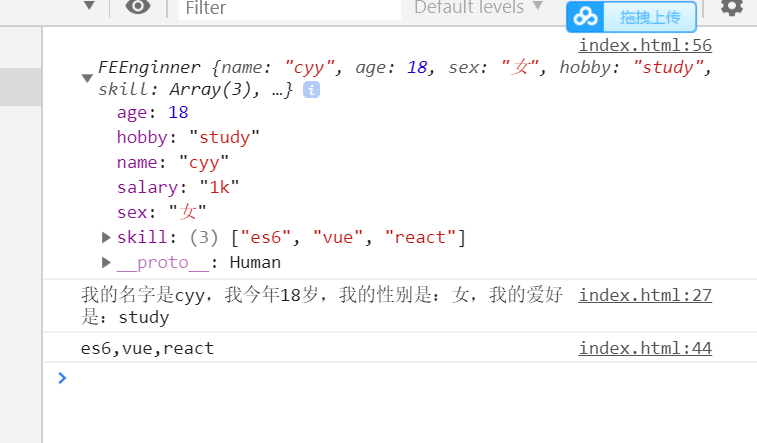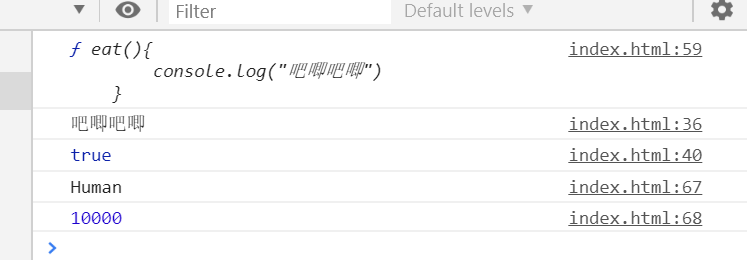Inheritance of class in ES6
Parent class (base class)
Subclass
extends keyword
//Parent class class Human{ //Constructor of the parent class constructor(name,age,sex,hobby){ this.name=name this.age=age this.sex=sex this.hobby=hobby } desc(){ const {name,age,sex,hobby}=this console.log(`My name is ${ name },I am this year ${ age }My gender is: ${ sex },My hobbies are: ${ hobby }`) } eat(){ console.log("Barking") } } //Subclass front end Engineer class FEEnginner extends Human{ constructor(name,age,sex,hobby,skill,salary){ super(name,age,sex,hobby)//stay this Previous call super,It's actually calling the constructor of the parent class this.skill=skill this.salary=salary } say(){ console.log(this.skill.join(",")) } } const feer=new FEEnginner( "cyy", 18, "female", "study", ["es6","vue","react"], "1k" ) console.log(feer) //Call the method of the parent class feer.desc() //Call subclass's own methods feer.say()

Professional system of simulated online games
Parent class: represents a role
Subclass: represents a professional role
class Character{ //Constructor of the parent class constructor(name,sex){ this.name=name this.sex=sex this.skill=[]//Skill } } //Sub Wizard class Wizard extends Character{ constructor(name,sex){ super(name,sex)//stay this Previous call super,It's actually calling the constructor of the parent class this.initSkill() } //Initialize skills initSkill(){ this.skill=[ { name:"Avada Kedavra", mp:666, level:999 }, { name:"Guardians curse", mp:333, level:888 } ] } }
Other content of super keyword
super
1. Called as parent constructor
2. Called as object
The first way, as shown above
The second way can be divided into two ways:
1. Accessing super - > parent prototypes in non static methods
2. Access super - > parent class in static method
When super is called, this of the parent class is always this of the child class
//super Called as object //Parent class class Human{ //Constructor of the parent class constructor(name,age,sex,hobby){ this.name=name this.age=age this.sex=sex this.hobby=hobby } desc(){ const {name,age,sex,hobby}=this console.log(`My name is ${ name },I am this year ${ age }My gender is: ${ sex },My hobbies are: ${ hobby }`) } eat(){ console.log("Barking") } checkThis(_this){ console.log(_this===this)//this Is the parent class. this,_this It's a subclass passed from a subclass this } } //Static attribute Human.total=10000 //Subclass front end Engineer class FEEnginner extends Human{ constructor(name,age,sex,hobby,skill,salary){ super(name,age,sex,hobby)//stay this Previous call super,It's actually calling the constructor of the parent class this.skill=skill this.salary=salary } say(){ //Access in non static methods super -> Parent prototype //console.log(super)//It's a mistake console.log(super.eat)//It's a mistake super.eat() // true In call super Of the parent class this Always subclass this super.checkThis(this)//Subclass this Pass the past } static test(){ //Access in static method super -> Parent class console.log(super.name)//Human console.log(super.total)//10000 } } const feer=new FEEnginner( "cyy", 18, "female", "study", ["es6","vue","react"], "1k" ) //Call subclass's own methods feer.say() FEEnginner.test()//Call static method

Simple polymorphism
The same interface, do different things in different situations
Same interface, different performance
In js, an interface can be understood as a method that needs to be implemented by a subclass
//polymorphic //If a subclass has a method with the same name as its parent, it will execute its own method and will not go to the parent's class Human{ say(){ console.log("I am a human") } } class Man extends Human{ say(){ super.say()//Call the method with the same name of the parent class console.log("I'm a little brother") } } class Woman extends Human{ say(){ super.say()//Call the method with the same name of the parent class console.log("I'm little sister") } } new Man().say() new Woman().say()

Overload demonstration: three cases
//Reload Demo 1 class simpleCalc{ add(...args){ if(args.length===0) return this.zero() if(args.length===1) return this.one(args) return this.sum(args) } zero(){ return 0 } one(args){ return args[0] } sum(args){ //accumulation return reduce((a,b)=>a+b,0) } }
//Reload Demo 2 function post(url,header,params){ //If there is no third parameter, the second parameter passed in is assigned to the params,header Default is null if(!params){ params=header header=null //undefind It's fine too } } post("https://baidu.com",{ a:1, b:2 })
//Reload demo 3 //Methods must be implemented by subclasses, or errors will be reported //Mapping table const ModelMap={ "Red eye zombies":1, "Pumpkin essence":2, "Cyclops":3, "Green eyes zombies":4, } //Basic monsters class Monster{ constructor(name,level,model){ this.name=name this.level=level this.model=model } attack(){ throw Error("Must be implemented by subclass`attack`Attack method") } } //Subclass red eye zombies class RedEyeZombie extends Monster{ constructor(name,level,model){ super("Red eye zombies",10,ModelMap["Red eye zombies"]) } } //Subclass green eyed zombies class GreenEyeZombie extends Monster{ constructor(name,level,model){ super("Green eyes zombies",20,ModelMap["Green eyes zombies"]) } attack(){ console.log("Green eyed zombies attack") } } const gez=new GreenEyeZombie() gez.attack() const rez=new RedEyeZombie() rez.attack()

Inheritance in ES5
//ES5 Implementation of inheritance in //Not real inheritance, but operation on prototype chain //1,Using constructors (cannot inherit methods on prototypes) //Parent class function P(){ this.name="parent"; this.gender=2; this.say=function(){ console.log("Okay okay, I'll be there"); } } P.prototype.test=function(){ console.log("I'm a prototype approach"); } //Subclass function C(){ P.call(this);//A way to implement inheritance this.name="child"; this.age=18; } var c=new C(); c.say(); //c.test();//Cannot inherit method on Prototype //The solution is to change the prototype of a subclass into an instance of a parent class function P2(){ this.name="parent"; this.gender=2; this.say=function(){ console.log("Okay okay, I'll be there"); } } P2.prototype.test=function(){ console.log("I'm a prototype approach"); } //Subclass function C2(){ P2.call(this);//A way to implement inheritance this.name="child"; this.age=18; } C2.prototype=new P2();//hold C2 The prototype of P2 (because P2 Instances of can access P2 Prototype approach) var c2=new C2(); c2.say(); c2.test();//Succeed in inheriting the method on the prototype
